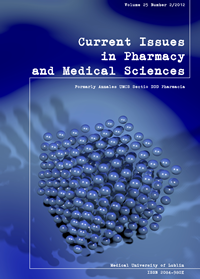Physical and chemical properties of cosmetic cream made of ingredients obtained from Juglans regia L.
DOI:
https://doi.org/10.12923/j.2084-980X/25.2/a.18Keywords:
cosmetic cream, walnut oil, 4-aminobenzoic acid, Juglans regia L.Abstract
The aim of the study was obtaining the cosmetic cream containing walnut oil, defatted walnut seeds and gelling agents like beeswax and witepsol. The walnut oil and defatted walnut seeds were received by extraction method using chloroform: methanol (1:1), (v/v). Then the physical and chemical properties of the cream were investigated. The consistency, drop point and flow temperature, the spreadability and rheological properties in the temperature range 22°C -50°C were estimated. The release of the model substance, 4-aminobenzoic acid, in the same range of temperatures, was defined as well. Previously, no studies had been conducted, in which the physicochemical properties of semisolid preparations with walnut oil and defatted walnut seeds would be estimated.
References
1. Achim M., et al.: Topical dosage forms containing fluidextract of Ruscus aculeatus: Formulation, preparation and physical characterization. Clujul Medical 83, 99, 2010.
2. Akhtar N. et al.: Formulation and in vitro evaluation of a cosmetic emulsion from almond oil. Pak. J. Pharm. Sci. 21, 430, 2008.
3. Akhtar N., Yazan Y.: Formulation and in-vivo evaluation of cosmetic multiple emulsion containing vitamin C and wheat protein. Pak. J. Pharm. Sci. 21, 45, 2008.
4. Amaral J.S. et al.: Triacylglycerol composition of walnut (Juglans regia L.) Cultivars: Characterization by HPLC -ELSD and Chemometrics J. Agric. Food Chem. 52, 7964, 2004.
5. Ballamann C., Mueller BW.: Stabilizing effect of cetostearyl alcohol and glyceryl monostearate as co-emulsifiers on hydrocarbon-free O/W glyceride creams. Pharm. Dev. Technol. 13, 433, 2008.
6. Bao-Yuan Guo et al.: Separation and determination of phpspholipids in plant seeds by nonhydrous capillary electrophoresis. J. Chrom. 1074, 205, 2005.
7. Behagel O., Rothman S., Schultze W.: Beziehugen zwischen selektiver Ultrafiolett absorption und chemischer Konstitution. Strahlentherapie 28, 110, 1928.
8. Bonferoni M.C., Rossi S, Ferrari F., Caramella C.: A modifies Franz diffusion cell for simultaneous assessment drug release and washability of mucoadhesive gels. Pharm. Dev. Technol. 4, 45, 1999.
9. Bucur L., Hirjau V., Istudor V.: Elaeagnus angustifolia L. flowers soft extract valorification in a dermatological preparation rheological control. Farmacia, 2009.
10. Bottan F., Di-Colo G., Namüpieri E. et al.: Influence of drug concentration on in vitro release of salicylic acid from ointment bases. J. Pharm. Sci. 63, 1979, 1974.
11. Ceulemans J., Santvliet Van L., Ludwig A.: Evaluation of continuous shear and creep rheometry in the physical characterization of ointments. Int. J. Pharm. 176, 187, 1999.
12. Delgado M.M., Bustamente-Rangel., Sanchez-Perez A., Pressurized liquid extraction prior to liquid chromatograpy with electrochemical detection for analysis of vitamin E isomers in seeds and nuts. J. Chrom. 1056, 249, 2004.
13. Eccleston G.M.: Structure and rheology of cetomacrogol creams: the influence of alcohol chain and homologue composition. J. Pharm. Pharmacol. 29, 157, 1977.
14. Polish Pharmacopoeia VIII, Vol. I-III, 2008.
15. Gloor M., Bettinger J., Gehring W.: Modification of stratum corneum quality by glycerin-containing external ointments. Hautarzt. 49, 6, 1998.
16. Hadi I.A., Ugrane H.E., Farouk A.M., Shayoub M.: Formulation of polyethylene glycol ointment bases suitable for tropical and subtropical climates. Acta Pharm. Hung. 59, 137, 1989.
17. Jimenez-Soriano M.M., Fresno- Contreras M.J., Selles F.: Development of a cream from a self-emulsifying base and moisturizing actives. II Farmaco 56, 513, 2001.
18. Korhonen M., Niskanen H., Kiesvaara J., Yliruusi J.: Determination of optimal combination of surfactants in creams using rheology measurements. Int. J. Pharm., 197, 143, 2000.
19. Lalor C.B., Flyn G.L., Weiner N.: Formulation factors affecting release of drug from topical formulation. 1. Effect of emulsion type upon in vitro delivery of ethyl p-aminobenzoate. J. Pharm. Sci. 83, 1525, 1994.
20. Moldavian M., Ciortea L.: Efficacy evaluation of different cream formulations on healthy skin properties. Farmacia 58, 787, 2010.
21. Onwuchekwa V.: Shea butter in cosmetics. Drug Cosmet. Ind. 131, 42, 1982.
22. Ozcan Mahmed Musa: Some nutrional characteristics of friut and oil of walnut (Juglans regia L.) Growing in Turkey. Iran J. Chem. Eng. 28, 57, 2009.
23. Rothman S., Rubin J.: Sunburn and paraaminobenzoic acid. J. Invest. Dermatol. 5, 445, 1945.
24. Salvador A., Chisvert A. Rodrigez A., March J.G: Indirect spectrophotometric determination of p-aminobenzoic acid in sunscreen formulation by sequential injection analysis. Anal. Chem. Acta 493, 233, 2003.
25. Taguchi M., Kunimoto T.: Jojoba wax in cosmetic creams and lotions. C&T 95, 39, 1980.
26. Tsamouris G., at al.: Lipid analysis of Greek walnut oil (Juglans regia L.) Z. Naturforsch. 57c, 51, 2002.
27. Walnut seed meal extract US Patent 6395261
28. Zwarts L., Savage G.P., Mc Neil D.: Fatty acid content of New Zeland – grown walnuts (Juglans regia L.) Am. J. Chin. Med. 25, 175, 1997.
Downloads
Published
Issue
Section
License
Copyright (c) 2012 Authors

This work is licensed under a Creative Commons Attribution-NonCommercial-NoDerivatives 3.0 Unported License.


